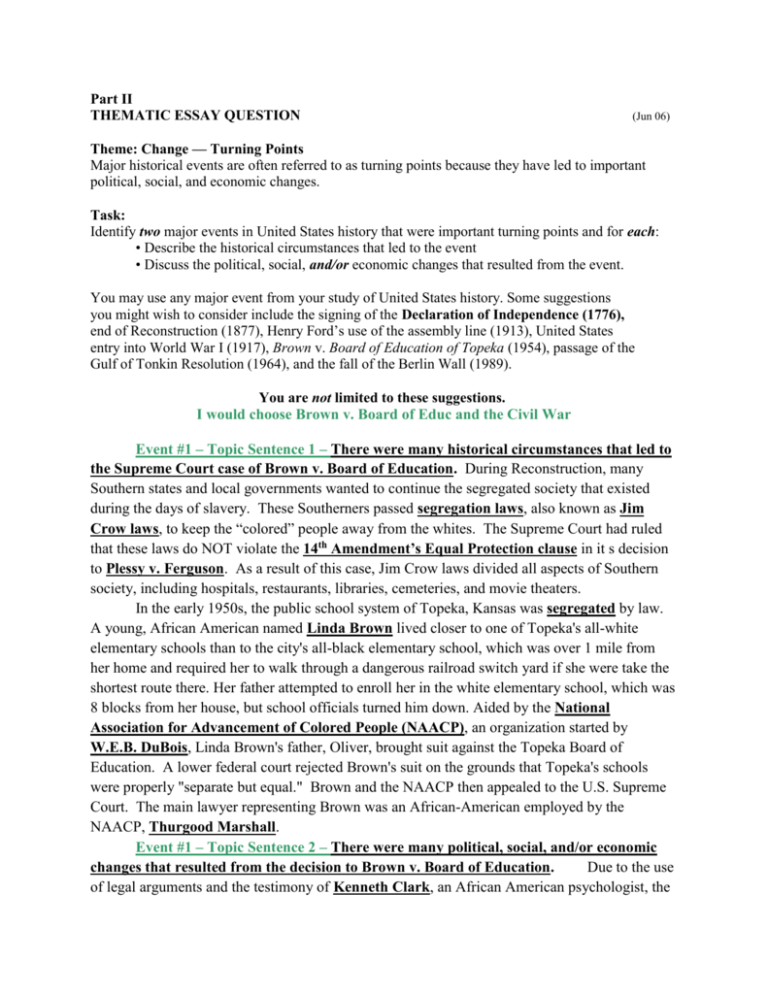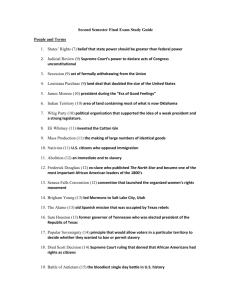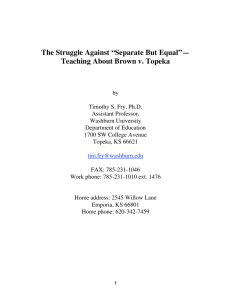US History Essay: Brown v. Board & Civil War Turning Points
advertisement

Part II THEMATIC ESSAY QUESTION (Jun 06) Theme: Change — Turning Points Major historical events are often referred to as turning points because they have led to important political, social, and economic changes. Task: Identify two major events in United States history that were important turning points and for each: • Describe the historical circumstances that led to the event • Discuss the political, social, and/or economic changes that resulted from the event. You may use any major event from your study of United States history. Some suggestions you might wish to consider include the signing of the Declaration of Independence (1776), end of Reconstruction (1877), Henry Ford’s use of the assembly line (1913), United States entry into World War I (1917), Brown v. Board of Education of Topeka (1954), passage of the Gulf of Tonkin Resolution (1964), and the fall of the Berlin Wall (1989). You are not limited to these suggestions. I would choose Brown v. Board of Educ and the Civil War Event #1 – Topic Sentence 1 – There were many historical circumstances that led to the Supreme Court case of Brown v. Board of Education. During Reconstruction, many Southern states and local governments wanted to continue the segregated society that existed during the days of slavery. These Southerners passed segregation laws, also known as Jim Crow laws, to keep the “colored” people away from the whites. The Supreme Court had ruled that these laws do NOT violate the 14th Amendment’s Equal Protection clause in it s decision to Plessy v. Ferguson. As a result of this case, Jim Crow laws divided all aspects of Southern society, including hospitals, restaurants, libraries, cemeteries, and movie theaters. In the early 1950s, the public school system of Topeka, Kansas was segregated by law. A young, African American named Linda Brown lived closer to one of Topeka's all-white elementary schools than to the city's all-black elementary school, which was over 1 mile from her home and required her to walk through a dangerous railroad switch yard if she were take the shortest route there. Her father attempted to enroll her in the white elementary school, which was 8 blocks from her house, but school officials turned him down. Aided by the National Association for Advancement of Colored People (NAACP), an organization started by W.E.B. DuBois, Linda Brown's father, Oliver, brought suit against the Topeka Board of Education. A lower federal court rejected Brown's suit on the grounds that Topeka's schools were properly "separate but equal." Brown and the NAACP then appealed to the U.S. Supreme Court. The main lawyer representing Brown was an African-American employed by the NAACP, Thurgood Marshall. Event #1 – Topic Sentence 2 – There were many political, social, and/or economic changes that resulted from the decision to Brown v. Board of Education. Due to the use of legal arguments and the testimony of Kenneth Clark, an African American psychologist, the Supreme Court reversed the decision in Plessy v. Ferguson claiming that separate but equal is inherently unequal. Clark had testified that although the segregated schools provided “equal” opportunity to learn, the psychological damage done by segregating students left minority children feeling inferior. Therefore, this broke the 14th Amendments guarantee of “equal protection under the law.” “We come then to the question presented: Does segregation of children in public schools solely on the basis of race, even though the physical facilities and other ‘tangible’ factors may be equal, deprive the children of the minority group of equal educational opportunities? We believe that it does.” - Chief Justice Earl Warren, writing on behalf of the unanimous Supreme Court. Shortly after the court’s ruling, the Supreme Court ruled that any segregated school system in the country would have to become racially desegregated with "all deliberate speed." Although the SC ruling was now law, there was great resistance in the South over this decision. Examples: Little Rock Nine – Arkansas governor posted units of the Arkansas National Guard around the Little Rock High School to stop African-American students from entering the building. President Eisenhower eventually enforced the SC’s ruling. Ruby Bridges - In early 1960, New Orleans was order by a federal court to integrate its schools. On November 14, 1960, the day decreed by the federal judge, Ruby Bridges and her mother were driven the five blocks to the school by four federal marshals. On that first day, six-year old Ruby and her mother spent their entire time in the principal’s office as white parents shouted angrily at them and quickly took their own children out of the school. Being New Orleans, little Ruby thought it was Mardi Gras with all of the fuss and commotion going on. On the next day, Ruby was again driven to school with her mother under the protection of four federal marshals. At school, they were greeted by a large protest that included a white woman holding a small black doll placed in a coffin. Within the building, Ruby was greeted by her new first grade teacher, Mrs. Henry – a transplant from Boston. Ruby was brought up to her classroom and Mrs. Henry allowed her to choose a desk. Ruby chose to sit in the front, which was a good thing since she was the only student in the class. Every white student that formerly attended the school was taken out by their parents for the remainder of the year. Event #2 – Topic Sentence 1 – There were many historical circumstances that led to the Civil War. The time period when these causes of the Civil War occurred was called Sectionalism. There were two major problems during this time period: the dispute over States Rights and Slavery. 1) States’ Rights - North supported the interests of the federal government - South believed in authority of the states - Reason for the difference: - Southern states were quickly losing political power at the federal level to the anti-slavery North because their booming population gave them more representation in the House of Representatives and the electoral college. - This leads to problems over issues like the tariff issue, and specifically, the Tariff of 1828, aka the Tariff of Abominations. These tariffs gave the northern manufacturing facilities protection by placing a 40% tax on imported goods. This hurt the Southerners that now had to pay higher prices for goods. South Carolina, under the leadership of John Calhoun, wrote the Issuance of Nullification, proclaiming the states authority to nullify federal law and to secede if they wanted to. Northerners disagreed with this while many Southern states agreed with South Carolina’s position. 2) Slavery - Started with 3/5 Compromise - Missouri Compromise of 1820: fight over representation in the Senate, had to create one slave state (Missouri) and one free state (Maine). Also created the 36 30 parallel, stating that all territories north of the line would be free and all those south would allow slavery - Compromise of 1850: Gave the Northerners another free state (California), but gave the South the authority to chase down escaped slaves with the Fugitive Slave Act. Also allowed territories to determine for themselves if they would be free or allow slavery. This is called popular sovereignty. - Dred Scott Case: Complicated matters more because the Supreme Court said that according to the Constitution, slaves were property and that the government could not take a citizen’s property without compensation - Final problem – Election of 1860 – Lincoln, an abolitionist in the eyes of the Southern voters, is elected to be President Event #2 – Topic Sentence 2 – There were many political, social, and/or economic changes that resulted from the Civil War. Since the South lost the Civil War, there were a series of proposals of what to do with the South. The first two plans that were proposed by President Lincoln and President Johnson were considered to be too lenient by the Radical Republicans that controlled Congress. These Radical Republican’s, instead had their own Congressional Plan, that punished the white Confederates and protected the civil liberties of freed slaves. Specifically, the South was divided into 5 military districts, a process known as Military Reconstruction. In addition, the Radical Republican Plan stripped Confederate officials of their political rights, forced the re-writing of state constitutions by whites and blacks, created schools for blacks through the Freedmen’s Bureau and required Southern states to ratify the 14th Amendment. The years of Reconstruction (1865 – 1877) had some positive and negative effects on the South: Positive: provided for a short lived freedom for African Americans in the South when the 13th, 14th, and 15th Amendments were ratified; development of Southern industries; reunited the Union; creation of schools for blacks Negative: Rights of freedmen were quickly stripped away with the passage of Jim Crow laws, Black Codes, and the existence of hate groups like the KKK. Southern white resentment of the North and the Republican Party; Racism in North and South; Economically speaking, the African Americans were just as bad off after slavery as during slavery.









